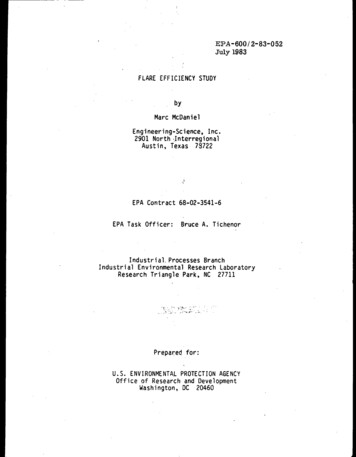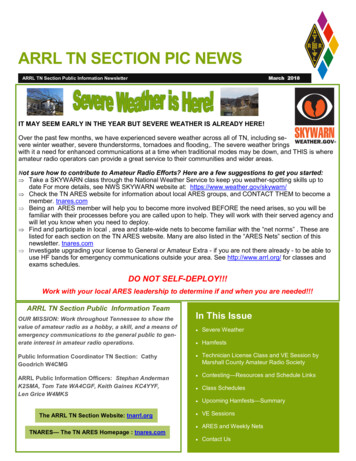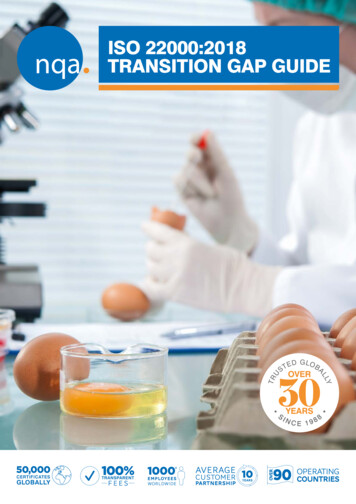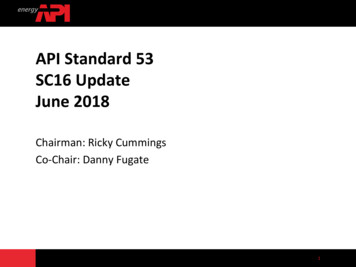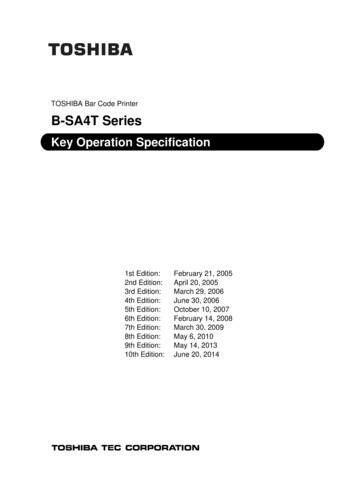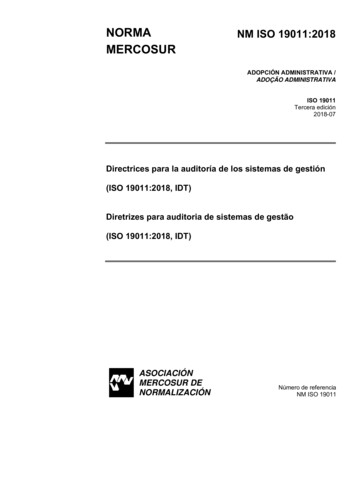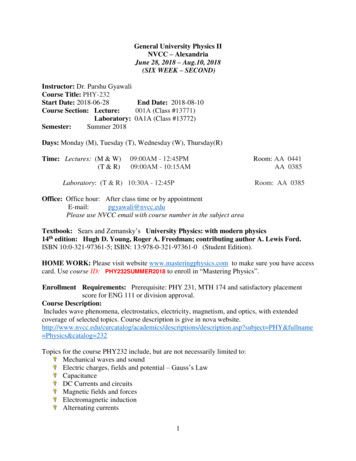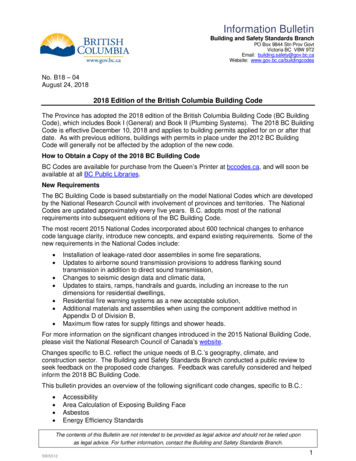
Transcription
Information BulletinBuilding and Safety Standards BranchPO Box 9844 Stn Prov GovtVictoria BC V8W 9T2Email: building.safety@gov.bc.caWebsite: www.gov.bc.ca/buildingcodesNo. B18 – 04August 24, 20182018 Edition of the British Columbia Building CodeThe Province has adopted the 2018 edition of the British Columbia Building Code (BC BuildingCode), which includes Book I (General) and Book II (Plumbing Systems). The 2018 BC BuildingCode is effective December 10, 2018 and applies to building permits applied for on or after thatdate. As with previous editions, buildings with permits in place under the 2012 BC BuildingCode will generally not be affected by the adoption of the new code.How to Obtain a Copy of the 2018 BC Building CodeBC Codes are available for purchase from the Queen’s Printer at bccodes.ca, and will soon beavailable at all BC Public Libraries.New RequirementsThe BC Building Code is based substantially on the model National Codes which are developedby the National Research Council with involvement of provinces and territories. The NationalCodes are updated approximately every five years. B.C. adopts most of the nationalrequirements into subsequent editions of the BC Building Code.The most recent 2015 National Codes incorporated about 600 technical changes to enhancecode language clarity, introduce new concepts, and expand existing requirements. Some of thenew requirements in the National Codes include: Installation of leakage-rated door assemblies in some fire separations,Updates to airborne sound transmission provisions to address flanking soundtransmission in addition to direct sound transmission,Changes to seismic design data and climatic data,Updates to stairs, ramps, handrails and guards, including an increase to the rundimensions for residential dwellings,Residential fire warning systems as a new acceptable solution,Additional materials and assemblies when using the component additive method inAppendix D of Division B,Maximum flow rates for supply fittings and shower heads. For more information on the significant changes introduced in the 2015 National Building Code,please visit the National Research Council of Canada’s website.Changes specific to B.C. reflect the unique needs of B.C.’s geography, climate, andconstruction sector. The Building and Safety Standards Branch conducted a public review toseek feedback on the proposed code changes. Feedback was carefully considered and helpedinform the 2018 BC Building Code.This bulletin provides an overview of the following significant code changes, specific to B.C.: AccessibilityArea Calculation of Exposing Building FaceAsbestosEnergy Efficiency StandardsThe contents of this Bulletin are not intended to be provided as legal advice and should not be relied uponas legal advice. For further information, contact the Building and Safety Standards Branch.59055121
Information BulletinBuilding and Safety Standards BranchPO Box 9844 Stn Prov GovtVictoria BC V8W 9T2Email: building.safety@gov.bc.caWebsite: www.gov.bc.ca/buildingcodes Exit SignsFactory Constructed BuildingsFenestrationHeritage BuildingsMid-Rise Combustible ConstructionWater Efficiency of Plumbing FixturesRadon DataStairsAccessibilityThe 2018 BC Building Code combines the requirements of the 2015 National Building Code withBC’s historical requirements to require a greater level of building accessibility. Newrequirements help improve accessibility in small retail shops, and common areas ofcondominium and apartment buildings, as well as permit greater flexibility in design choices.Please read Bulletin B18-05 for more information on this update.Area Calculation of Exposing Building FaceThe 2018 BC Building Code clarifies the requirements for fire protection between adjacentresidential and small buildings in Part 9 and better aligns with the language and intent of Part 3.The change provides clarity for buildings divided into fire compartments that it is permitted, butnot mandatory, to calculate the area of the exposing building face for each compartment, as analternative option to taking the exposing building face as the exterior wall area facing in onedirection on any side of the building.AsbestosThe 2018 BC Building Code removes all direct references that permitted asbestos-containingproducts. The Building Code does not ban asbestos-containing products, however asbestoscontaining products are no longer listed among acceptable materials due to the potential risk tothe health and safety of builders and building occupants.Energy Efficiency StandardsThe 2018 Building Code references new editions of energy efficiency codes and standards.New buildings meeting ANSI/ASHRAE 90.1-2016, “Energy Standard for Buildings Except LowRise Residential Buildings” or the “National Energy Code for Buildings 2015” will improve theirenergy performance, and the new requirements contribute to the Province’s goal of requiringnet-zero energy ready buildings in the BC Building Code by 2032.Exit SignsThe National Building Code and BC Building Code reference two co-ordinated InternationalOrganization for Standardization (ISO) standards for the design of exit signs. The 2018 BCBuilding Code retains the versions referenced in the 2012 BC Building Code of these twostandards, which are aligned with the references to the directional arrows in the 2015 NationalBuilding Code and the 2018 BC Building Code.Factory Constructed BuildingsThe portion of the appendix related to CSA A277 “Procedure for Factory Certification ofBuildings” was deleted when the previous exemption for these buildings was removed from theThe contents of this Bulletin are not intended to be provided as legal advice and should not be relied uponas legal advice. For further information, contact the Building and Safety Standards Branch.59055122
Information BulletinBuilding and Safety Standards BranchPO Box 9844 Stn Prov GovtVictoria BC V8W 9T2Email: building.safety@gov.bc.caWebsite: www.gov.bc.ca/buildingcodes2012 BC Building Code. This appendix note has been re-inserted to clarify how conformancewith the CSA A277 standard relates to the 2018 BC Building Code.FenestrationWindows, doors, and skylights may conform to either the 2008 or 2011 version of “NAFS –North American Fenestration Standard/Specification for Windows, Doors, and Skylights”(NAFS), and to either the 2009 or 2017 the version of the “Canadian Supplement to NAFS –North American Fenestration Standard/Specification for Windows, Doors, and Skylights”(Canadian Supplement).Heritage BuildingsThe table of alternate compliance methods for heritage buildings is unique to B.C. and differsfrom the National Building Code. Editorial corrections and updates to include current referenceshave been made to the table. The table has also been moved from the appendix into the bodyof the code (Division A) to clarify that its requirements are an enforceable part of the code.Mid-Rise Combustible ConstructionFollowing consultations with industry stakeholders and based on extensive research andevaluation, the BC Building Code has adopted the 2015 National Building Code provisions formid-rise combustible buildings with a variation specific to B.C. The variation will require100 percent of the exterior cladding to have increased fire performance and 10 percent of thebuilding’s perimeter to be located within 15 metres of a street or streets. More information onthis update can be found in Bulletin B18-06 on mid-rise combustible construction.Water Efficiency of Plumbing FixturesPlumbing fixture efficiency requirements have been relocated from the BC Building Code Book I(General) to Book II (Plumbing Systems). In addition, some new requirements have beenadopted from the 2015 National Plumbing Code to help achieve consistent requirements acrossCanada. Changes to flow rates are reproduced in the following table, but do not apply tolavatories in health care facilities, emergency eye washes, or emergency showers. In additionto flow rates for public lavatories and showers, automatic shut off requirements are introduced.Fixture Flow RatesFixtureFlow Rate measured in L/minPrivate lavatory supply Reduced from 8.3 to 5.7Public lavatory supplyReduced from 8.3 to 1.9Kitchen supplyUnchanged at 8.3Shower headReduced from 9.5 to 7.6There is no change to the flush cycle requirements for water closets, however the maximumwater usage per flush cycle for non-residential urinals is reduced from 5.7 Lpf to 1.9 Lpf.Radon DataPart 9 of the BC Building Code requires some buildings to have a radon rough-in for a subfloordepressurization system, in locations of the province where there is evidence of radonThe contents of this Bulletin are not intended to be provided as legal advice and should not be relied uponas legal advice. For further information, contact the Building and Safety Standards Branch.59055123
Information BulletinBuilding and Safety Standards BranchPO Box 9844 Stn Prov GovtVictoria BC V8W 9T2Email: building.safety@gov.bc.caWebsite: www.gov.bc.ca/buildingcodesconcentrations in buildings exceeding Health Canada guidelines. While the Building Code doesinclude a list of areas where radon is known to be an issue, new data is continually beingreported regarding radon concentrations in locations of the province that were previously notknown to be an elevated radon risk. The authority having jurisdiction may have dataestablished by bylaw or policy which determines if the radon rough-in provisions of the BCBuilding Code apply. In the absence of such data from the authority having jurisdiction, TableC-4 in Division B of the BC Building Code, which has been revised to reflect new evidence, canbe used. Now, Table C-4 lists radon rough-ins as required in some locations that werepreviously not known to have an elevated risk of indoor radon concentrations exceeding HealthCanada guidelines. New locations listed as “required” in Table C-4 are: AbbotsfordDuncanHopeLillooetSecheltWhistlerMore information on radon rough-in requirements can be found in Bulletin B14-07.StairsImportant changes have been made to stair requirements to improve safety and ease of use forall occupants. The 2018 BC Building Code does not include permissions adopted in the2015 National Building Code for mixed flights and spiral stairs within a dwelling unit.Education and TrainingThe Building and Safety Standards Branch is working with partners to support code users inlearning about the new code requirements. Additional information about education and trainingopportunities will be posted to www.gov.bc.ca/buildingcodes.Code DevelopmentCodes are constantly changing to reflect new technologies and practices. National model codesare developed by committee, and information on how to participate on a committee, or attend acommittee meeting is available in the following links. To participate in the development ofCodes, Code Change Requests can be sent to the National Research Council of Canada.Links Codes Canada: (volunteer & attend) odes centre index.htmlMinistry website: uctionindustry/building-codes-standardsNRC Code Change Request: odes centre/code change request.html Contact the Building and Safety Standards Branch General inquiries can be sent to building.safety@gov.bc.caTechnical Code inquiries can be sent to codequestion@gov.bc.caThe contents of this Bulletin are not intended to be provided as legal advice and should not be relied uponas legal advice. For further information, contact the Building and Safety Standards Branch.59055124
Information BulletinBuilding and Safety Standards BranchPO Box 9844 Stn Prov GovtVictoria BC V8W 9T2Email: building.safety@gov.bc.caWebsite: www.gov.bc.ca/buildingcodesThe Building and Safety Standards Branch does not enforce compliance with the BC BuildingCode. Local governments are authorized to enforce the BC Building Code through the LocalGovernment Act and the Community Charter.The contents of this Bulletin are not intended to be provided as legal advice and should not be relied uponas legal advice. For further information, contact the Building and Safety Standards Branch.59055125
2018 Edition of the British Columbia Building Code . The Province has adopted the 2018 edition of the British Columbia Building Code (BC Building Code), which includes Book I (General) and Book II (Plumbing Systems). The 2018 BC Building Code is effective December 10, 2018 and applies to bui
